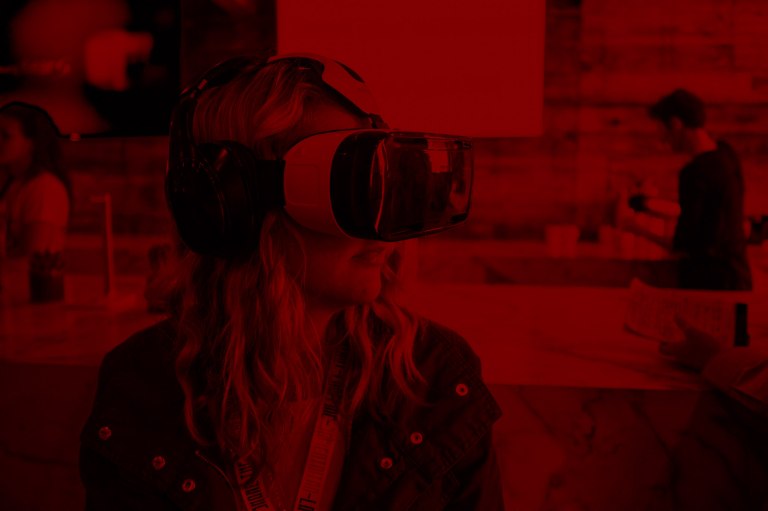Why Virtual Reality Is Probably Not Ever Actually Going To Happen
This is also why ‘mobile social games’ and things like that don’t work. Things like FourSquare that are designed to make people ‘be more social’ are inefficient - you could ‘check in’ someplace and then check your Twitter to see who else has checked in there and wait for your friends to reply via social…

If you were around in the 1980s and early 1990s, you might remember that people used to think ‘virtual reality’ was a really big deal, or was going to become a big deal in the future. This was represented via a lot of 3D shit, overuse of computer-generated imagery [rad ‘3D’ skateboarding animation characters, overuse of internet terms like ‘byte’ and dudes with ‘flat top’ hair styles] and those portrait backgrounds you could request on middle school portrait day that were, like, some kind of sparkling neon grid. In worst-case scenarios the grids formed some kind of ‘vortex’ behind the head of the obliquely-smiling child sitting for the portrait. Who would choose portraiture of their child that caused the child to appear as if the child were being sucked into a vortex, I just don’t know.
Even prior to the 1980s, and prior to the point wherein every single crime show began to incorporate a shitty token ‘this criminal was addicted to an online game’ episode, or a ‘this criminal played a violent video game and then killed people in the real world’ episode, or a ‘this criminal used behavior within a virtual computer world to simulate and/or warn of his real crimes something something hackers etc’, modern societies have been fascinated with the idea of ‘virtual reality’, even if that means ‘you sit in a dark room wearing giant sunglasses and then stuff materializes and you think it’s real’ [see also Star Trek holodeck, laser tag, Blade Runner, William Gibson, every derivative sci-fi book ever, probably Kurt Vonnegut because somebody always brings up Kurt Vonnegut and makes you listen to their screed about him].
Anyway, the ‘VR’ fantasy has persisted ever since it became possible to conceive of ‘man’s relationship with technology’ as a ‘thing that will never go away’. The idea that people will someday be able to completely escape into some simulated universe is enormously seductive for two reasons: one, because it just seems fun, like dreaming while awake, promising a lifelike multidimensional ‘universe’ that is like this one but better and where consequences don’t exist.
The second and more salient reason that the idea of ‘virtual reality’ has always appealed to people is because it seems so logical. The escapist nature of the human nature is well understood, and no matter what degree of technology man has had available to him thus far, he has always been able to create some kind of theory of the fake-real therewith, some kind of ‘alternate reality’, even if that is a network of rooms described in blinky green text or a crude robot toy that plays cassette tapes.
The kind of mind that likes to dream about how ‘science’ will advance needs only the skeleton-frame of the plausible to create a vision of the future. Because people have always wanted a ‘flying car’ someone will one day make one just because, and will show it off while smiling on the morning news and people will watch it and go ‘oh, the future is almost here.’ But the idea that that one flying car will immediately portend the mass production of a fleet of flying cars of varying models disregards the fact that the world is sewn crucially together via a network of roads made for not-flying cars, that there is a massive and complex transportation industry globally that has been built over a century for numerous machines excluding cars flying or otherwise, that it would be extremely difficult to adapt the existing system legally, economically, structurally and socially to accommodate flying cars when the extant infrastructure is so strongly at odds with them.
Similarly, numerous ideas about ‘virtual reality’ – specifically, the concept where an individual interacts in a 3D environment through an ‘avatar’ that represents themselves – neglect basic principles of efficiency as well as of demand. Time and time again consumers of interactive entertainment have demonstrated they don’t want to simulate life; if something can be done ‘IRL’ an individual will generally realize that the most direct way of doing it is the most preferable and they will turn off the machine and just go do it.
In other words, sci-fi dudes who are really into the ‘future possibility space’ envisioned a world where everyone has an alternate self existing in a virtual environment, they can log into the virtual environment and navigate the alternate self over to a virtual clothing store and buy some virtual clothing and not only will their avatar get a new virtual outfit but the tangible physical clothing item will be delivered via normal shipping routes to the tangible physical individual’s real-world home.
However, the manifestation of ‘virtual shopping’ is that someone just goes to Amazon and clicks like 2 buttons and purchases what they want to have delivered to their home. The act of logging into a virtual environment, electing to ‘inhabit’ a digital avatar, navigating a lifelike ‘virtual space’ and shopping at a ‘virtual store’ is an excessive protraction that, once its novelty wears off, merely inhibits the basic task the individual wants to perform. Human beings gravitate toward the most abstracted interfaces possible. No one will want to simulate gesture and movement when one button-touch suffices.
This is also why ‘mobile social games’ and things like that don’t work. Things like FourSquare that are designed to make people ‘be more social’ are inefficient – you could ‘check in’ someplace and then check your Twitter to see who else has checked in there and wait for your friends to reply via social networking. Or you could just, like. Text them.
Or better yet, you could actually go to the place with your friend in person and not need to ‘social network’ in any way. The most ‘social’ thing to do is the simplest and most direct, with the ‘interface’ as minimal as is reasonable, and absent whenever possible.
Of course, the explosion of ‘motion control interfaces’ onto the video game scene strongly challenges the notion that an abstracted interface is preferable to a literal or simulated one. On the back of its ‘Wii Remote’, Nintendo’s Wii has sold more units than pretty much any console ever. Newly-launched interfaces for the Xbox 360 [gesture-based, controller-less, with body-tracking] and for the PlayStation 3 [a motion wand like the Wii’s except more precise and with a ‘depth’ axis] are also showing strong ‘momentum’ among those consumers who enjoy dance, exercise, sport and other so-called ‘casual’ and/or mass-market titles.
As the act of ‘swinging an object to simulate a tennis racket’ or ‘punching the air literally so that a game character will punch some nonthreatening boxing opponent on the screen’ or stuff like that is quite literal and not in any way abstract, the popularity of these new devices doesn’t make initial sense in the context of this argument, until you look at the ‘big picture’ and notice that these industry trends represent only like a minor portion of the video game industry’s revenues, the vast majority of which come from traditional games and other extremely accessible, single-touch titles [e.g. ‘Angry Birds’ etc].
Also probably most people bought a Wii because they thought it was an exercise machine and they played Super Mario Galaxy a lot and now they no longer use it/have possibly sold it to someone, based on things people tell me when they realize my job is to write about video games and they don’t know what else to say.
While the novelty of literal and simulation technology excites people initially, developments on this ‘scene’ are destined to be relegated to fad status and people will assign permanence to stuff that actually makes sense to use regularly and efficiently in daily life.
The only things people want to ‘simulate’ are things they have a fixation on enjoying that are impossible or unacceptable in real life, which is why Second Life remains a thriving home for ‘furries’ ‘babyfurs’ stuff like that… I guess it makes sense, because when most science fiction fans really think about ‘what would I do with a holodeck’ they think of like… ‘sex with like Deanna Troi or something’. God, bringing sexuality into the world of science fiction is always so weird. But you might be able to do that in virtual reality someday, someone will probably make that I bet. ![]()



